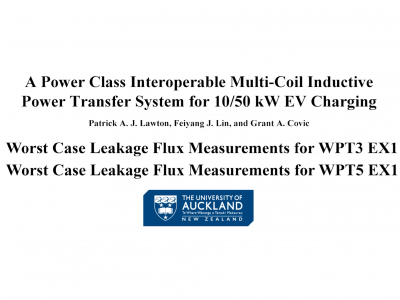Wireless Power Transfer (WPT)

The project focuses on the development and evaluation of an innovative magnetic coupler designed for in-wheel wireless charging systems in electric vehicles (EVs). This technology aims to enhance the efficiency and convenience of EV charging by integrating the charging mechanism directly into the vehicle's wheels. The magnetic coupler utilizes principles of wireless power transfer (WPT) through magnetic induction and resonance, allowing for effective energy transfer even with misalignment and varying distances between the transmitter and receiver coils.
- Categories:
 72 Views
72 Views
This paper introduces an innovative inductive power transfer (IPT) system tailored for electric vehicle (EV) charging, emphasizing dynamic IPT implementations that utilize electrified roadways with integrated couplers. To tackle the challenges of complexity and reliability associated with current systems, we propose a Push-Pull Driven Coupler Array (PPCA) architecture. This design employs only N+1 switches to independently energize N primary couplers, enabling simultaneous activation of multiple couplers while mitigating current stress on the switches.
- Categories:
 70 Views
70 Views
Wireless power transfer (WPT) systems for electric vehicles (EVs) need to accommodate different vehicle models with varying battery voltages and Z classes, while ensuring the power, efficiency, volume, cost, and compatibility of different vehicle assemblies (VAs). To address these challenges, this article proposes a series-parallel dual rectifier architecture based on the LCC-S compensation network. The characteristics of conventional topologies are analyzed mathematically, which may have a low output power under large coupling coefficient variations.
- Categories:
 107 Views
107 ViewsThis experiment is from the paper "A Power Class Interoperable Multi-Coil Inductive Power Transfer System for 10/50 kW EV Charging" (10.1109/OJPEL.2024.3514519), and presents an Inductive Power Transfer (IPT) system for Electric Vehicle (EV) charging with Power Class Interoperability (PCI) between the SAE WPT3 (10 kW) and WPT5 (50 kW) power classes using a multi-coil Bi-Polar Pad (BPP) Vehicle Assembly (VA) magnetic topology.
- Categories:
 132 Views
132 Views
Autonomous underwater vehicles (AUVs) are extensively utilized for underwater resource exploration, requiring inductive power transfer (IPT) systems with large output power to achieve quick charging. However, underwater positioning errors result in significant variations in the coupling coefficient of the IPT system. Moreover, AUVs employ diverse battery types and voltages, exacerbating the issue of decreased transferred power when the coupling coefficient and battery voltage are low, thereby prolonging the AUVs' charging time.
- Categories:
 98 Views
98 Views
MatWPT is an innovative software to support designers during the analysis and development of Wireless Power Transfer (WPT) systems. The software, developed as a Matlab toolbox, receives the key system characteristics as inputs, such as compensation topology, operating frequency and desired output power. Then, using evolutionary optimization, provides potential design options for meeting the performance criteria defined by the designer, in terms of output power and efficiency.
- Categories:
 78 Views
78 Views
Different countries have various grid voltages, and different electric vehicles (EVs) have different chassis heights. Conventional EV wireless power transfer (WPT) solutions require designing different circuits for various input voltages and using different compensation circuits for different transmission distance classes which hinders the widespread adoption of the WPT technique. To address these two issues, this paper proposes an EV WPT system based on series-parallel inverters. The mathematical model of this system is established, and the expression for output power is derived.
- Categories:
 119 Views
119 Views
The traditional wired charging mode requiresautonomous underwater vehicles (AUVs) to be salvaged to the ship for energy replenishment, which cannot work continuously and is complicated to operate. To address this issue, since the battery voltages of AUVs are low, a convenient high-current wireless power transfer (WPT) system is introduced for the AUV batteries with low-voltage, it may cause large losses in the receiving coil and an unbalanced current-sharing issue among the rectifier diodes.
- Categories:
 184 Views
184 Views
Wireless power transfer (WPT) systems for electric vehicles (EVs) require wide-range voltage gains to satisfy battery charging requirements and coupling coefficient variations. However, existing solutions typically require additional DC-DC converters, or may suffer from discontinuous output voltage and hard switching. To solve these problems, this paper proposes a primary-side hybrid modulation method that can achieve wide-range voltage regulation and zero voltage switching (ZVS) simultaneously.
- Categories:
 139 Views
139 ViewsThis paper presents a vehicle side wireless synchronization controller suitable for high-power inductive power transfer (IPT) systems for electric vehicle (EV) wireless charging under stationary and semi-dynamic conditions. The objective of this work is to enable improved functionality, efficiency, and power density of high-power IPT systems under misaligned conditions. An existing 50 kW LCL-LCL tuned IPT system with dual active bridges (DAB) demonstrates the controller’s performance.
- Categories:
 224 Views
224 Views
